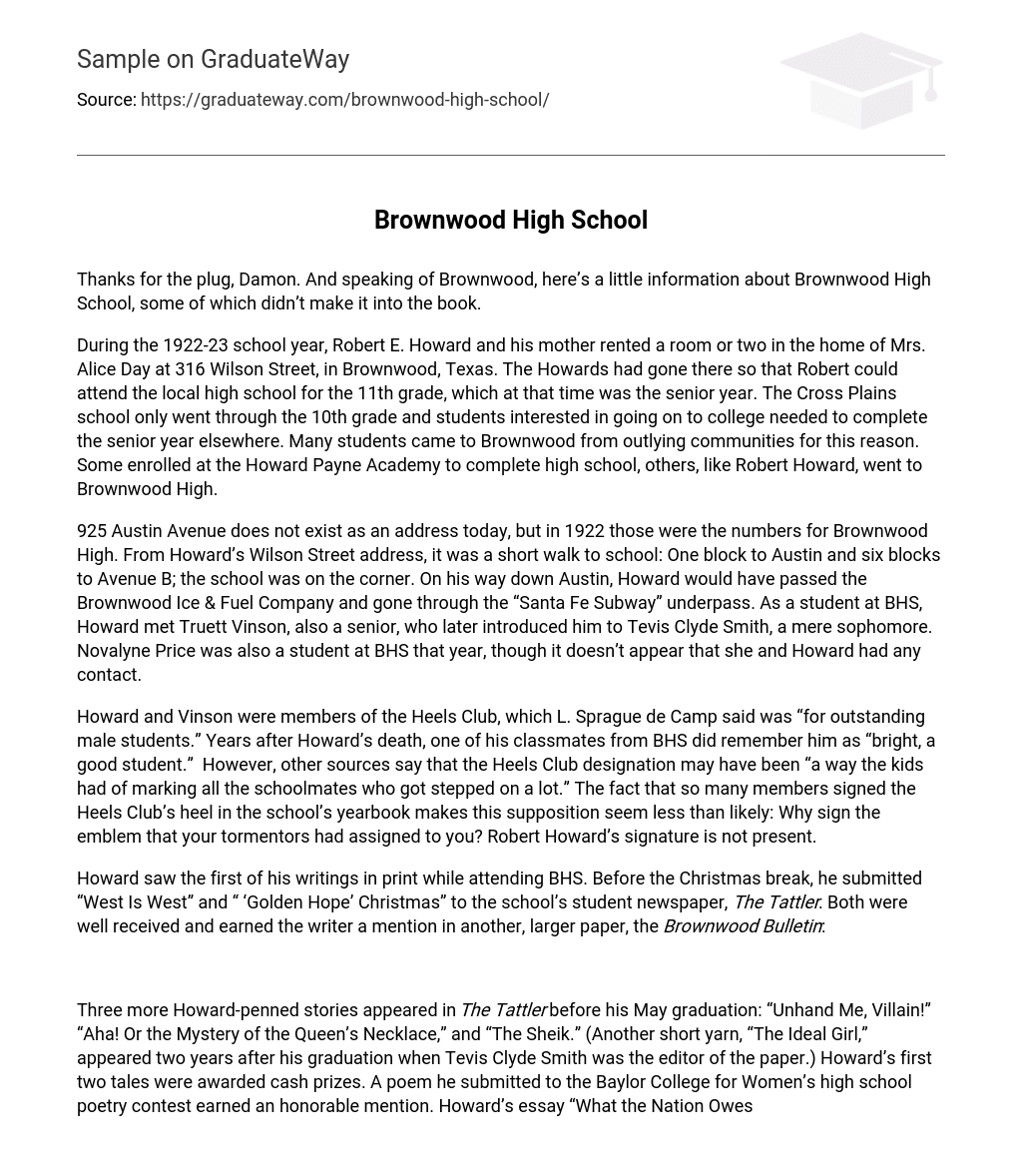Thanks for the plug, Damon. And speaking of Brownwood, here’s a little information about Brownwood High School, some of which didn’t make it into the book.
During the 1922-23 school year, Robert E. Howard and his mother rented a room or two in the home of Mrs. Alice Day at 316 Wilson Street, in Brownwood, Texas. The Howards had gone there so that Robert could attend the local high school for the 11th grade, which at that time was the senior year. The Cross Plains school only went through the 10th grade and students interested in going on to college needed to complete the senior year elsewhere. Many students came to Brownwood from outlying communities for this reason. Some enrolled at the Howard Payne Academy to complete high school, others, like Robert Howard, went to Brownwood High.
925 Austin Avenue does not exist as an address today, but in 1922 those were the numbers for Brownwood High. From Howard’s Wilson Street address, it was a short walk to school: One block to Austin and six blocks to Avenue B; the school was on the corner. On his way down Austin, Howard would have passed the Brownwood Ice & Fuel Company and gone through the “Santa Fe Subway” underpass. As a student at BHS, Howard met Truett Vinson, also a senior, who later introduced him to Tevis Clyde Smith, a mere sophomore. Novalyne Price was also a student at BHS that year, though it doesn’t appear that she and Howard had any contact.
Howard and Vinson were members of the Heels Club, which L. Sprague de Camp said was “for outstanding male students.” Years after Howard’s death, one of his classmates from BHS did remember him as “bright, a good student.” However, other sources say that the Heels Club designation may have been “a way the kids had of marking all the schoolmates who got stepped on a lot.” The fact that so many members signed the Heels Club’s heel in the school’s yearbook makes this supposition seem less than likely: Why sign the emblem that your tormentors had assigned to you? Robert Howard’s signature is not present.
Howard saw the first of his writings in print while attending BHS. Before the Christmas break, he submitted “West Is West” and “ ‘Golden Hope’ Christmas” to the school’s student newspaper, The Tattler. Both were well received and earned the writer a mention in another, larger paper, the Brownwood Bulletin:
Three more Howard-penned stories appeared in The Tattler before his May graduation: “Unhand Me, Villain!” “Aha! Or the Mystery of the Queen’s Necklace,” and “The Sheik.” (Another short yarn, “The Ideal Girl,” appeared two years after his graduation when Tevis Clyde Smith was the editor of the paper.) Howard’s first two tales were awarded cash prizes. A poem he submitted to the Baylor College for Women’s high school poetry contest earned an honorable mention. Howard’s essay “What the Nation Owes the South” was awarded a medal at his graduation and printed in the Brownwood Bulletin shortly after commencement. Upon graduating, Howard and his mother returned to Cross Plains.
In 2002 the Santa Fe Subway was replaced by an overpass. That same overpass forced a reassignment of addresses on Austin Avenue. Most of the old school building’s front yard was taken over by the new overpass, as was its address: 925 Austin Avenue is now located under tons of asphalt, but the old building survives, with a new address: 901 Avenue B. And, while the words “High School” are still clearly etched in the stonework of the building, those words can only be seen by entering through the side entrance of the Family Services Building.
Once full of enthusiastic students, teachers and administrators, today the building houses the offices of the local Big Brother chapter and other organizations. Gone are the lockers and desks, but if visitors go up to the second floor, they can almost hear the echoes of the old school bell.





